It’s an amazing feeling to know that you are the only person for miles.
I love the days when I can walk all day without seeing another soul.
Unfortunately, that’s not always the case, and as some of America’s most popular hiking trails seem to be bursting at the seams, we need to learn how to share hiking trails in a way that doesn’t disrupt others too much.
When you add bicycles, horses, and dogs to the mix on a multi-use trail, the puzzle gets a little trickier.
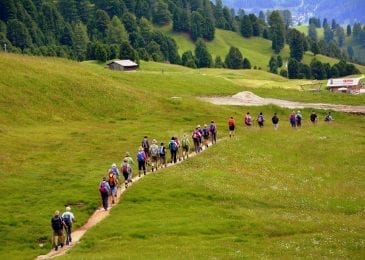
We need to be able to share.
All the folks on the trail, regardless of how they are traveling, have one thing in common: they are all there to enjoy nature.
It’s hard to do that, however, when you’re worried about your horse kicking someone, or your child getting hit by a mountain bike.
Following good trail etiquette should make sharing the hiking trails (or all of them), at the very least, tolerable.
The following are some commonly recognized trail etiquette principles to help you avoid being unpleasant.
Sharing the Trail: The Etiquette
I. Hikers
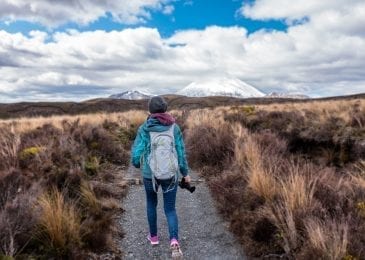
Many rules of the road apply to hiking trails as well.
Such as:
- Stay to the right when you meet oncoming traffic (or the left if you are in a country that drives on the left side).
- Overtake a slower hiker on the left.
- Hike single file, unless you can walk side-by-side and still leave half the trail free for others to pass.
- Walking side by side on a narrower trail not only makes it tough for others to pass, but also contributes to trail widening and erosion.
- If you need to take a beak, step to the side so others can pass.
- The uphill hiker should have the right of way.
- Don’t tailgate.
- Unless you are planning on passing, keep your distance from the people in front of you.
- If someone is behind you, give them the opportunity to pass, lest you spend the next hour with them breathing down your neck.
Getting into the uphill rhythm can take a while, and some people really aren’t going to want to break that.
However, uphill hikers will often use the opportunity to stop and rest.
II. Bicycles
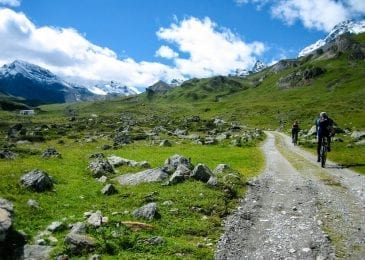
It’s a cyclist’s job to yield to hikers, but that doesn’t mean the hiker gets to be rude.
- The attention is turned on cyclists because they are faster and often move too quietly for people to know they are approaching.
- But a cyclist who has to stop midway up a steep hill will likely have to push their bike the rest of the way.
- Meanwhile, a cyclist heading downhill may have misjudged their stopping ability.
- It’s up to the cyclist to make themselves known, keep their speed under control, and yes, get out of the way or even dismount.
- But they sure will appreciate you stepping to the side for a brief moment to let them pass.
If you are a hiker, stay off of mountain bike trails.
- Mountain bikers will not be expecting you, and not keeping their speed under control.
- Mountain bikers often lovingly maintain these trails with their own money and time so they can race down them without worrying about pedestrians.
- They want an adrenaline rush, but not the kind that involves barreling into you.
If you’re a cyclist, don’t expect people to step aside for you.
It’s your job to avoid them.
- Keep your speed under control, especially on single tracks.
- Give a shout before heading around corners or down hills.
- If some of your group is out of sight, let people know how many more in your group there are.
- When you are approaching someone from behind, give them an “on your left” warning as you approach from behind so you don’t startle them, even on wider trails.
For the rest of the time, those same traffic rules apply – stay to the right and overtake on the left.
III. Horses
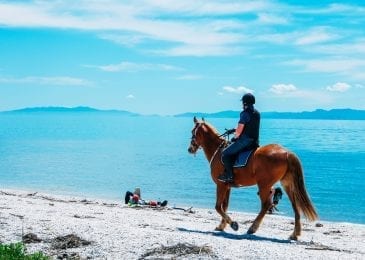
Cyclists and hikers should both yield to horses.
Horses can be unpredictable and do not always do exactly what their riders command.
- Horses can’t see behind them, so if you approach from behind and surprise them, you might be in trouble.
- Make yourself known from as far back as you can to let the rider and horse know you are there.
- If you need to pass from behind, mind the hind legs.
- Give the horse as much space as possible and, once again, make sure the horse and rider know you are there.
- If they are coming towards you, give them a wide berth and step off the trail if need be.
- Don’t make any sudden movements and make sure your dog (if you are with one) is under control.
- Flapping clothes could also spook a horse.
- General etiquette rules dictate that you should stand on the downhill side while letting a horse pass.
- Horses may spook if you are on the uphill side (like a predator about to pounce), and when they do get spooked, they tend to go uphill.
Hills notwithstanding, it’s best to step off the trail to the right.
If ever unsure, just talk to the rider.
Be wary of kids or people on guided trips.
They will likely not have the same control of their mounts as other folks on the trail.
If you’re a horseback rider, keep your speed under control.
- Try to stay aware of other trail users approaching from either direction and pay attention to your horse – they will likely hear someone coming before you do.
- If someone needs to pass from behind, mind where your horse’s hindquarters are.
- Your horse may not be a kicker, but the hiker doesn’t know that!
- Remember that, even if you live in horse country, some people just don’t have horse sense.
- If they seem nervous or oblivious, talk to them.
As with bikes and humans, stay to the right, pass to the left, and let people know that you’re behind them.
What about poop, you ask?
Usually, horse poo is part of the multi-use trail experience.
- Horse poo does not carry pathogens that can harm humans or wildlife and is not so nitrogen-rich that it kills plants.
- As far as poo goes, it smells okay (as opposed to, say, dog poo).
- On urban trails or busy trails, it’s common for riders to dismount and kick their horses poo off the trail.
- This is often as a courtesy, but sometimes the rules require it.
- Some hiking trails even require that riders bring a bag to pack it out.
Riders, it’s in your best interest to at least kick it off the trail, even if the rules don’t require it.
If too many people complain, horses may not be allowed on the trail at all.
Also, clean up the area around your trailer.
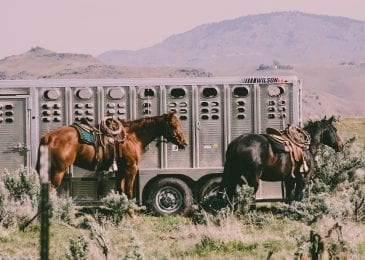
As for wilderness areas, people are usually more tolerant of horse poop.
Riders should still clean up their camp area and break spots.
IV. Dogs
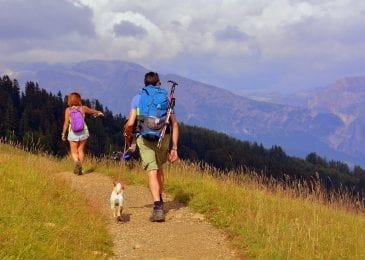
Dog lovers, I’m terribly sorry to tell you this: not everyone wants your dog running up to them to sniff and play.
In fact, some people are straight up scared of dogs, even your well behaved one that always stays by your side.
There also may be unfriendly dogs or wildlife about.
- If the rules require that you keep it on a leash, then keep it on a leash.
- If you are allowed to have your dog off leash, make sure that you keep it under control.
- Dogs will often not be allowed on horse trails, busy trails, hiking trails, or onto sensitive wilderness areas.
Please respect these rules.
Unlike horse poo, dog poo does cause problems.
- Aside from smelling terrible, it can spread diseases to other dogs, wildlife, and even humans.
- Also, it is so rich in nitrogen that it will kill plants.
- Bring bags for your dog’s droppings and pack them out – don’t just throw the bag in the bushes or leave it on the side of the trail to pick up later (because you might forget).
- If your dog poops on the side of the trail, you’re not in the clear.
Consider the poor park worker who has to weed wack there next (speaking from experience here).
I repeat, just pick it up and pack it out!
Some Other Ways to Respect Other Trail Users
Since we are talking about respecting each other here, I thought I might mention a few of the other things to help keep the peace on the trail.
1. Obey the Rules
There are often lots of rules on trails, and there is always a good reason for them.
If you think a rule is silly, ask the land manager about it.
They should have a good reason and are usually happy to share.
2. Take Nothing, Leave Nothing

I shouldn’t need to say it.
I mean, who litters actually litters anymore?
Sadly, a lot of people do.
Pack out your garbage. All your garbage.
- No apple cores in the bushes (which can attract animals), or tissues in the fire pit.
Just pack it out.
- Also, if you are feeling extra nice, pack a bag for picking up other people’s garbage.
I can guarantee that you’ll find some.
- Leave the flowers, the arrowheads, and the cool rocks behind.
Aside from giving others the chance to enjoy it, you could be damaging the ecosystem, or removing evidence of a cultural site.
- The laws differ from place to place, but most parks and protected land do not allow people to take cool bits of nature home.
- If you think you’ve found an undocumented cultural site, report it to the US forest service (or the equivalent in your country)
3. Keep the Noise Down and the Earbuds Out
One of the things that drive me absolutely bonkers is music on the trail.
I love the time away from technology, so when I have to put up with someone else’s music, I am not a happy hiker.
Most people who head out into the wilderness would rather be listening to birds singing and the wind in the trees.
Also, keep your voices down if there are other people around!
Here’s the really bad news if you are a music lover – it’s not a great idea to keep your earbuds in.
You might end up jumping out of your skin when someone tries to pass.
There is also the issue of your safety.
It would be easy for an animal to sneak up on you if you can’t hear it.
If you must, keep just one bud in.
In Conclusion, If You Can’t Remember All This…
Just be respectful!
If you aren’t sure if you have the right of way, step to the side.
If you are worried about a horse or dog or cyclist, talk to them (or their owners).
Most people are happy to answer your questions.
If someone is showing poor etiquette, it’s okay to (very nicely) talk to them about it.
Usually, they’re not trying to be jerks, they just don’t know.
Have you got any hiking trails etiquette tips of your own?
Recommended Read: Enough Excuses! Time to Start Backpacking